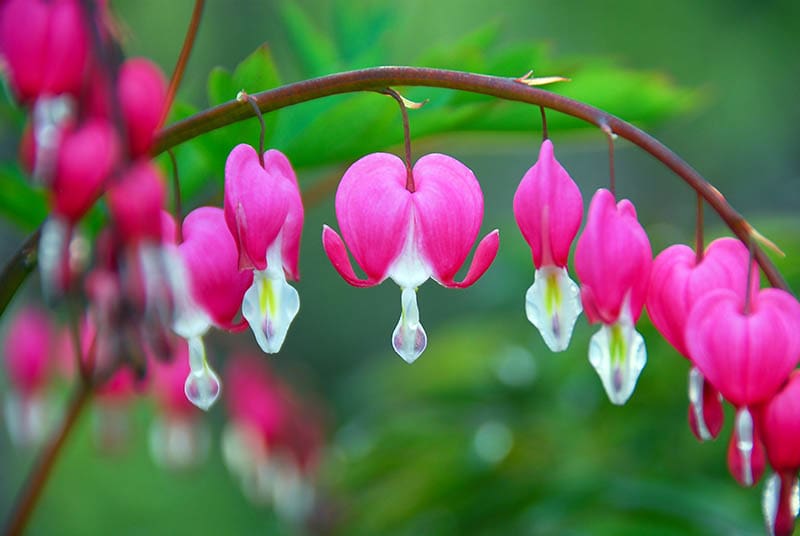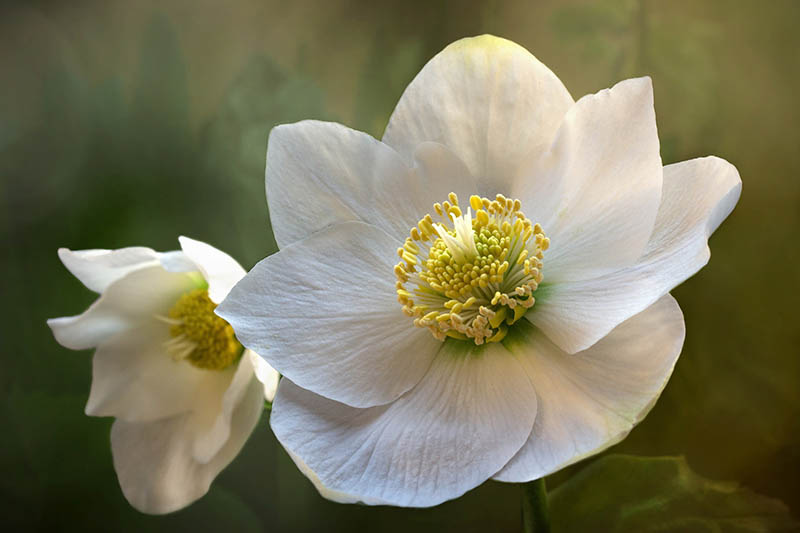10 Companion Plants for Hostas (With Pictures)
-
Pete Ortiz
- Last updated:

There are over 3,000 registered varieties of hostas that come in different textures and colors. These hardy clump-forming perennials are prized for their gorgeous foliage display. Hostas are shade-tolerant, easy to grow, and thrive with minimal attention.
Although hostas may produce beautiful, scented flowers in summer, they are typically grown for their broad leaves and dense growth. Their flowers appear ragged in just a few days, and it’s typical for gardeners to cut them off. To enjoy a pop of color in your garden during blooming seasons, you must pair hostas with other plants.
So, which plants pair well with hostas and thrive in shady spots and rich organic soil with a slightly acidic pH? Read on!
The 10 Great Companion Plants for Hostas
1. Bleeding Hearts

| Hardiness Zones: | 3 to 9 |
| Mature Size: | 1 to 3 ft. tall, 2 to 3 ft. wide |
| Flower Color: | Pink, white, red |
Bleeding hearts are perennials best known for their heart-shaped pink flowers that droop from long, bending stems. These puffy flowers have a bulging white petal that resembles a drop. Like hostas, they thrive in shady spots and depreciate or go dormant during the summer if exposed to high levels of heat or sun. Fortunately, they pop back to life each year in spring or fall.
Pairing your hostas with bleeding hearts can help add contrast to your garden. Each bleeding heart produces up to 20 small, pretty flowers on its stems. Once the plants are well-established, you can look forward to enjoying a breathtaking scene each spring.
2. Daffodils

| Hardiness Zones: | 3 to 8 |
| Mature Size: | 6 to 30 inches tall, 6 to 12 inches wide |
| Flower Color: | Yellow, cream, white, orange, or pink |
There are over 50 species of daffodils that come in a delightful variety of blossoms. From the traditional showy flowers with yellow and white hues to unique trumpet-shaped blooms, you’ll be spoilt for choice when choosing the species to add a burst of colorful spring blooms to your yard. These dependable perennial bulbs are easy to grow and are pretty beginner friendly.
Daffodils are great companion plants for hostas because they bloom earlier than most perennials. Also, their blooming season lasts longer, assuring you of six weeks to six months of ornamental split cups, single blooms, doubles, or trumpets.
3. Astilbes

| Hardiness Zones: | 3 to 8 |
| Mature Size: | 1 to 4 feet tall, 18 to 30 inches wide |
| Flower Color: | White, pink, violet, soft lavender, or deep red |
Astilbe flowers are showy and often the focal point of shady flower beds. The blooms are tall, with fluffy plumes towering above the fern-like foliage. There are over 25 species of Astilbe, and your flowers’ color will highly depend on the species you plant.
Astilbe flowers range in hues, from dark purples and deep reds to whites and pinks. They are perfect companions for shade-tolerant plants like hostas because of the contrasting deep green foliage and beautiful blooms that can give any garden a proper summer facelift.
4. Japanese Painted Ferns

| Hardiness Zones: | 5 to 8 |
| Mature Size: | 12 to 24 inches tall with an equal width |
| Flower Color: | blue-gray with silvery sweeps |
Most ferns are shade-tolerant, and one of the best species to pair with your hostas is the Japanese Painted Fern. Combining hostas with broad leaves and the lacy foliage of ferns can give your shade garden an alluring tropical feel. The two plants make an interesting contrast because of the differences in their leaf shapes and overall hues.
Japanese painted ferns are hardy perennials with showy silvery sweeps of soft mounded foliage. The leaves have a blue-gray hue, which sets the species apart from typical ferns with green fronds. That’s where the plant gets the name “painted” fern.
5. Toad Lily

| Hardiness Zones: | 4 to 9 |
| Mature Size: | 24 to 36 inches tall, 18 to 24 inches wide |
| Flower Color: | blue-gray with silvery sweeps |
If you want to add an element of interest to a shady spot in your garden, the toad lily is one of the best plants to consider. It is no surprise that this eye-catching plant with unusual flowers makes a pretty good companion for hostas. It grows well under trees and other shady spots in the landscape that hardly receive any sunshine.
Also known as tiger lily, the toad lily is a hardy perennial that can grow 24 to 36 inches tall. It blooms in late summer to produce lacy flowers with six white to yellow petals and six stamens. Three pistils emerge from the center of the flower to form the illusion of a serpent’s tongue. The most striking bit is the purple spots covering the star or bell-shaped blooms.
6. Coleus

| Hardiness Zones: | 11 and warmer |
| Mature Size: | 6 inches to 3.5 ft. tall, 1 to 3 ft wide |
| Flower Color: | Purple, red, orange, green, pink, and yellow |
Coleus is a gorgeous bedding plant that can give your shade garden a pop of color through all seasons. While it can grow in full sun, it also thrives in shady landscapes. Coleus does produce tiny blue and white blooms, although most gardeners grow it primarily for its striking foliage.
Coleus can be annuals or perennials, depending on where they grow. The plant comes in various shades, including purple, red, orange, green, pink, and yellow. There is also a range of leaf shades, shapes, patterns, and sizes, including varieties with spots and lobed or toothed edges.
7. Impatiens

| Hardiness Zones: | 10 to 11 |
| Mature Size: | 10 to 16 inches tall, 10 to 15 inches wide |
| Flower Color: | White, red, pink, violet, coral, purple, or yellow |
Hostas and Impatiens combined can make your flower beds more visually attractive. Impatiens plants have bright-hued blooms that can be white, red, pink, violet, coral, purple, or yellow. While the plant is technically a perennial, it grows as an annual in most gardens. Also, it can grow in shady areas or landscapes that receive partial sun and shade.
When properly spaced, impatiens plants grow 10 to 17 inches tall. However, they can grow up to 30 inches tall when closely spaced. If you want the flowers to remain low to the ground, make sure you leave 8 to 12 inches of space between each plant.
8. Foxgloves

| Hardiness Zones: | 4 to 10 |
| Mature Size: | 3 to 5 ft. tall, 18 to 24 inches wide |
| Flower Color: | white, purple, yellow, red, or pink with dark spots |
Another shade-loving plant that makes a worthy companion for your hostas is foxgloves. The plant produces alternating, ovate to oblong foliage centered towards the lower section of the step. On one side, a cluster of bell-shaped flowers forms every spring. These flowers can be white, purple, yellow, red, or pink with dark spots.
Foxgloves are biennials and flower during their second year of life and die once they seed. Nonetheless, they can add vertical interest to your hostas garden with their ornamental blooms.
9. Hellebores

| Hardiness Zones: | 3 to 9 |
| Mature Size: | 1–2 ft. tall with a similar spread |
| Flower Color: | Apricot, green, yellow, metallic blue, dusky pink, slate maroon, or white. |
Not so many suitable hostas companions can give you a welcome sight of beautiful flowers in late winter. The Hellebores are shade and winter hardy and will sometimes show their blooms when the ground is still heavy with snow. The best part is that these flowers are long-lasting and can fill your yard with an inviting fragrance.
Apart from the blooms, hellebores also have stunning green foliage that can give your landscape a visual appeal when it’s not in bloom. The plant is an evergreen perennial capable of stealing the heart of beginner gardeners for its minimal care requirements. You only need to beware that all parts of the plant are toxic to pets and humans.
10. Elephant Ears

| Hardiness Zones: | 9 to 11 |
| Mature Size: | 1–2 ft. tall with a similar spread |
| Flower Color: | Rich emerald green, black, brown, or chartreuse gold |
“Elephant ears” is a dramatic, exotic perennial that can grow in shade or partial shade and sun. The tropical plant is loved for its stunning huge heart-shaped leaves that can brighten your outdoors all year round. Also, the plant is fast-growing and reaches its full size in as little as two months under optimal conditions.
Like hostas, elephant ears prefer acidic soil. While the most common species have rich emerald green leaves, some varieties have a black, brown, or chartreuse gold hue. For the best outcome, pair cultivars with a lighter shade with your hostas. If the leaves have a darker hue, they will need more sun to maintain their hue.
What Are the Worst Companion Plants for Hostas?
Pairing hostas with other plants can add more diversity to your garden without increasing your gardening workload. The right combination will make your landscape more visually appealing, and the wrong companion plant can look unnatural growing next to your hostas.
Hostas pair well with fine-textured plants because their foliage creates contrast against their boldly textured leaves. Because hostas typically form a dense cluster of cascading leaves, they also contrast nicely with upright and carpeting plants. Flowers that can add a pop of color during blooming seasons would also make great companions.
So, which are the worst companion plants?
When looking for companion plants for hostas, it’s crucial to ensure your picks do more than thrive under similar growing conditions. For instance, avoid pairing your hostas with large maples, willows, and cherries. These plants are some of the worst companions because they have fibrous roots that compete with your hostas for water, minerals, and other vital resources. Your hostas will likely choke on the root mat or die for lack of water and minerals.
Final Words
Growing a shade garden doesn’t have to be stressful, provided you pick the right combination of plants. While hostas are a top choice for most gardeners, it makes sense to pair them with other plants that thrive in shady spots and bloom in spring or summer.
Our list is by no means exhaustive. While there are numerous other plants to consider, we handpicked perennials, annuals, and shrubs that are pretty beginner friendly. Irrespective of your gardening skills, you are bound to fall in love with growing and caring for these plants.
Good luck choosing a perfect personalized combination!
Featured Image Credit: F. Muhammad, Pixabay
Contents


